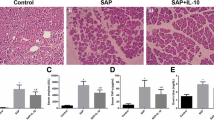Abstract
Background and aims
Pancreatic encephalopathy (PE) is a severe complication and significant cause of death in patients with severe acute pancreatitis (SAP). We have reported previously that low-molecular-weight heparin (LMWH) treatment could reduce incidence of PE in SAP patients. Our objective here was to investigate the protective effect of LMWH and its mechanism on PE in SAP rats.
Methods
SD rats were randomly divided into three groups: (1) Sham-operation (S) group, (2) SAP group, and (3) LMWH treatment (LMWH) group. LMWH was administrated 4 h after the SAP model conducted. The levels of serum amylase, myelin basic protein (MBP), tumor necrosis factor-alpha (TNF-α), interleukin 6 (IL-6), brain water content, occurrence of apoptosis, and pathological changes of pancreas and brain were measured at 1 day after models were set up in the SAP and S groups, and 1 day after LMWH treatment was administrated in the LMWH group.
Results
(1) The levels of serum amylase, TNF-α, and IL-6 in the SAP group were increased significantly more than those in the S and LMWH groups (all P < 0.001), as were the levels of serum MBP in the SAP group compared to those in the S and LMWH groups (P < 0.01, <0.05 respectively). However, while the level of serum amylase and IL-6 in the LMWH group were significantly increased compared to those in the S group (P < 0.05, <0.001 respectively), the levels of TNF-α and MBP showed no significant difference between the LMWH and S groups (all P > 0.05). (2) The brain water content in the SAP group was significantly increased compared to the S group and LMWH group (P < 0.01, <0.05 respectively). (3) Neuronal apoptosis, demyelination, and mitochondrial vacuolation in neuronal cells were observed in the SAP group; in contrast, in the LMWH group, significantly lower rates of neuronal apoptosis, demyelination and mitochondrial edema were observed in neuronal cells.
Conclusions
The protective effect of LMWH on PE progression in SAP rats might result from inhibition of inflammatory activation and reduction of the occurrence of neuronal apoptosis.


Similar content being viewed by others
Abbreviations
- LMWH:
-
Low-molecular-weight heparin
- SAP:
-
Severe acute pancreatitis
- PE:
-
Pancreatic encephalopathy
- LT:
-
Low-molecular-weight heparin treatment
- S:
-
Sham operation
- ELISA:
-
Enzyme-linked immunosorbent assay
- MBP:
-
Myelin basic protein
- TNF-α:
-
Tumor necrosis factor-alpha
- IL-6:
-
Interleukin-6
- TNM:
-
Tumor node metastasis
References
Menza MA, Murray GB. Pancreatic encephalopathy. Biol Psychiatry. 1989;25:781–4.
Lu XS, Qiu F, Li YX, Li JQ, et al. Effect of lower-molecular weight heparin in the prevention of pancreatic encephalopathy in the patient with severe acute pancreatitis. Pancreas. 2010;39(4):516–9.
Qiu F, Lu XS, Huang YK. Effect of low molecular weight heparin on pancreatic microcirculation in severe acute pancreatitis in rats. Chinese Medical J. 2007;120:2260–3.
Lu XS, Qiu F, Li JQ, Fan QQ, et al. Low molecular weight heparin in the treatment of severe acute pancreatitis: a multiple centre prospective clinical study. Asian J Surg. 2009;32:89–94.
Pitchumoni CS, Agarwal N, Jain NK. Systemic complications of acute pancreatitis. Am J Gastroenterol. 1988;83:597–606.
Zhang XP, Tian H. Pathogenesis of pancreatic encephalopathy in severe acute pancreatitis. Hepatobiliary Pancreat Dis Int. 2007;6:134–40.
Sharf B, Bental E. Pancreatic encephalopathy. J Neurol Neurosurg Psychiatry. 1971;34:357–61.
Farkas G, Marton J, Nagy Z, Mándi Y, et al. Experimental acute pancreatitis results in increased blood–brain barrier permeability in the rat: a potential role for tumor necrosis factor and interleukin 6. Neurosci Lett. 1998;242:147–50.
Fernandes AO, Campagnoni CW, Kampf K, Feng JM, et al. Identification of a protein that interacts with the golli-myelin basic protein and with nuclear LIM interactor in the nervous system. J Neurosci Res. 2004;75:461–71.
Strand T, Alling C, Karlsson B, Karlsson I, et al. Brain and plasma proteins in spinal fluid as markers for brain damage and severity of stroke. Stroke. 1984;15:138–44.
Bhatia M, Wallig MA, Hofbauer B, Lee HS, et al. Induction of apoptosis in pancreatic acinar cells reduces the severity of acute pancreatitis. Biochem Biophys Res Commun. 1998;246:476–83.
Cao Y, Adhikari S, Clement MV, Wallig M, et al. Induction of apoptosis by crambene protects mice against acute pancreatitis via anti-inflammatory pathways. Am J Pathol. 2007;170:1521–34.
Nakamura Y, Do JH, Yuan J, Odinokova IV, et al. Inflammatory cells regulate p53 and caspases in acute pancreatitis. Am J Physiol Gastrointest Liver Physiol. 2010;298:G92–100.
Caroppi P, Sinibaldi F, Fiorucci L, Santucci R. Apoptosis and human diseases: mitochondrion damage and lethal role of released cytochrome C as proapoptotic protein. Curr Med Chem. 2009;16:4058–65.
Saxena G, Chen J, Shalev A. Intracellular shuttling and mitochondrial function of thioredoxin-interacting protein. J Biol Chem. 2010;285:3997–4005.
Hao LN, Zhang QZ, Yu TG, Cheng YN, Ji SL. Antagonistic effects of ultra-low-molecular-weight heparin on Aβ25-35-induced apoptosis in cultured rat cortical neurons. Brain Res. 2011;1368:1–10.
Talley AK, Dewhurst S, Perry SW, Dollard SC, et al. Tumor necrosis factor alpha-induced apoptosis in human neuronal cells: protection by the antioxidant N-acetylcysteine and the genes bcl-2 and crmA. Mol Cell Biol. 1995;15:2359–66.
Acknowledgments
This work was supported by a Medical and Scientific Grant from Hunan Province (y02-012, to X.S. Lu).
Author information
Authors and Affiliations
Corresponding author
Additional information
Responsible Editor: Artur Bauhofer.
Rights and permissions
About this article
Cite this article
Qiu, F., Lu, Xs. & Huang, Yk. Protective effect of low-molecular-weight heparin on pancreatic encephalopathy in severe acute pancreatic rats. Inflamm. Res. 61, 1203–1209 (2012). https://doi.org/10.1007/s00011-012-0517-8
Received:
Revised:
Accepted:
Published:
Issue Date:
DOI: https://doi.org/10.1007/s00011-012-0517-8




